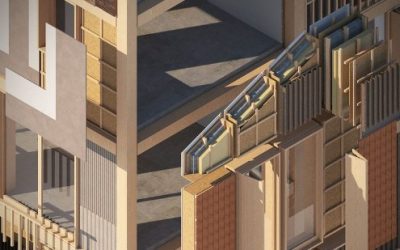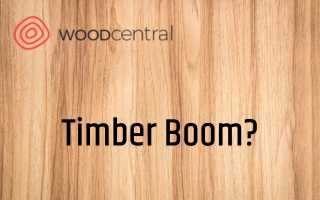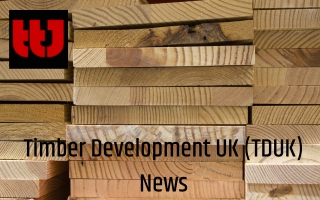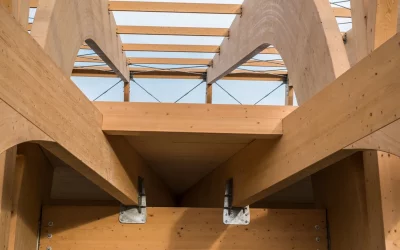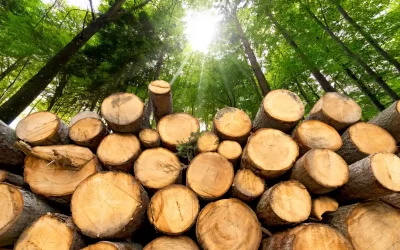Written by Wood Campus
Environmental | Industry | News
If asked to imagine a wind turbine, most people would think of a steel structure—the current form of nearly all wind turbines used for renewable wind energy generation. However, despite what the steel industry claims, it’s hardly a given that wind turbines must be made of steel. Modvion, a Swedish engineered-wood technology company that develops modular designs, believes it’s not only feasible but that towers should be built from wood.
Futurist Jim Carroll observes that this rethinking of wind turbines’ materials aligns with two key trends: one, the broader acceleration of new material science; and two, the emergence of a “real focus on how to utilise wood in construction in ways that weren’t previously possible”.
Compared to traditional wind towers, Modvion’s modular towers are easier to transport, comprised of lighter component parts and cheaper to scale. Modvion CEO Otto Lundman explains: “Conventional towers are shipped in cylinders, which becomes a logistical issue at greater heights. Modvion towers use a modular design, allowing good logistics at much greater heights.” Modvion towers’ efficiency gains are best realised at heights over 120 metres.
Although steel is stronger than wood per volume, Modvion’s Laminated Veneer Lumber (LVL) and Gluelam Timber (GLT) products are both 55% stronger than steel per mass unit and more cost-effective than steel at the same load-bearing capacity. “Modvion towers with strength properties equal to steel towers weigh two-thirds as much and cost less to produce,” says Lundman.
Wood can also create additional advantages beyond cost and strength. Unlike steel, which is often shipped over great distances, timber is often locally available, benefiting local jobs and economies.
Robert Jockwer, an assistant professor of Timber Structures at Chalmers University, adds that wood is also superior to steel for maritime climates. While saltwater is harsh on steel, “saltwater doesn’t have such a negative impact on timber. It shouldn’t get wet, but the maritime climate, with some salt in the air, is not a problem for timber. For these special climates, timber can be better than steel.”
Continue Reading: UPM TIMBER
More News
Timber Square: London’s net-zero landmark project
STA CEO Andrew CarpenterNet-zero ambition for Timber Square in London As reported by Ramtech, Timber Square is an ambitious project by Landsec aimed at achieving net-zero in London. The site, which spans over 370,000 sq ft, is safeguarded by Ramtech’s WES3 wireless...
STA – Government has an opportunity to re-shape housebuilding with timber frame playing a key role.
STA CEO Andrew CarpenterAndrew Carpenter, CEO of the Structural Timber Association (STA), writes about how the Government has an opportunity to re-shape housebuilding with timber frame able to play a key role. “In her first speech as Chancellor of the Exchequer,...
Arup launches global guide on building safely with timber
Tested by fire Inside the “Believe in Better” building, the UK’s tallest timber commercial building (Courtesy of Arup)Arup has published a global guide on how to build fire-safe mass timber structures to encourage more use of the low-carbon alternative to concrete and...
UK Timber Design Conference
Timber Development UK is proud to announce our exciting new conference focused on a low carbon transformation of our built environment using timber. Taking place on 26 June 2024, the UK Timber Design Conference will bring together disruptors and market leaders to...
Swedish Wood hosts high level event at the Residence of the Ambassador of Sweden to the UK
(left to right, Baroness Hayman of Ullock, Shadow Spokesperson for the Environment, Food and Rural Affairs; Stefan Gullgren, the Ambassador of Sweden to the UK; Lord Khan of Burnley, Shadow Spokesperson for Levelling up, Housing and Communities)Last Thursday 23rd, 40...
Will Prince William’s Bold Pledge Spark a Timber Boom?
The Prince of Wales has acted on his commitment to build low-carbon social housing on the $1 Billion-plus Dutchy of Cornwall lands.The Prince of Wales is spearheading a new initiative to construct social and affordable housing on the lands of the $1-billion plus...
TDUK releases UK timber product embodied carbon data
Timber Development UK (TDUK) has released average carbon data for the 10 major timber product categories. The data will support architects, engineers and other specifiers to make accurate assessments of the carbon impacts of their material choices as early in the...
Worlds tallest buildings mass timber revolution
As a part of Dezeen's Timber Revolution series, they have rounded up the world's 10 tallest buildings with mass-timber structures, including an engineered-wood shopping-centre extension and a carbon-negative cultural centre. Compiled using data from the Council on...
Think Wood’s 10 most popular projects of 2023
Think Wood is a communications campaign that provides commercial, multifamily and single-family home design and build resources to architects, developers, and contractors. Recently Think Wood announced its 10 most popular timber construction projects of 2023. Across...
Timber in construction roadmap UK policy
The Government has committed to growing and maintaining a sustainable and long-term supply of domestic timber and wood products in the 2023 Environmental Improvement Plan. We have awarded £7.6 million through the Woodlands into Management Forestry Innovation Funds to...




